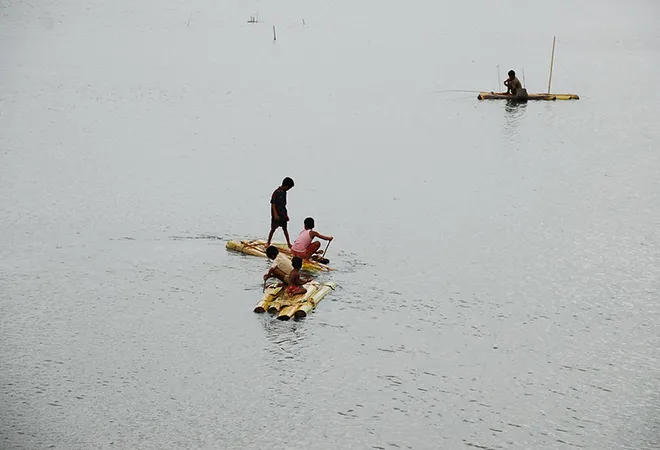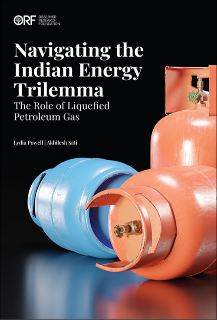
This article is part of the series — India–Bangladesh Relations @50: Commemorating Bilateral Ties.
After 50 years, relations between Bangladesh and India stand at an important juncture; it is a landmark moment for the two long-standing and tested friends. This is the moment for drawing a new and fresh collaboration roadmap on all the strategic areas of mutual and equitable benefit for the two geographically contiguous neighbours. Climate change, which has been the global poster agenda for the last two decades, could be used as a strategic area for further cementing a genuine and substantive collaboration.
South Asia, as a region, is home to about 1.7 billion people, over one quarter of whom are still living in poverty. Bangladesh and the eastern part of India, including West Bengal, have both coastlands and low- to medium- elevation lands, with lush green forests including the Sundarbans in the south and southwest coasts of Bangladesh. Obviously, shared borders coupled with high concentration of poverty and population density have rendered the region especially vulnerable to climate change impacts. Successive reports of the Intergovernmental Panel on Climate Change predict a grim future for South Asia.
This is the moment for drawing a new and fresh collaboration roadmap on all the strategic areas of mutual and equitable benefit for the two geographically contiguous neighbours.
Take the case of Amphan, the super cyclone that made its landfall last May with almost 200 square kilometres of wind speed per hour, which was unprecedented in the region. It caused massive destruction, particularly in West Bengal. This coastal region, populated by 58 million people across the two maritime borders, has some of the most vulnerable communities in South Asia: Poor farming and fishing communities in the Sunderbans, and over a million Rohingya refugees living in the crowded camps of Cox’s Bazar in Bangladesh.
These are stark pointers that Bangladesh and India should unite to jointly address such ferocious climate impacts and to build their adaptive capacity and resilience. The fact remains that the South Asian Association for Regional Cooperation (SAARC) over the last two decades has not been very effective, despite having numerous declarations on climate change and several regional centres for collaboration in research and data collection. Obviously, political will across the region has not been strong enough to address the technical obstacles to have an effective regional platform to address climate impacts and adaptation.
For pragmatic reasons, Bangladesh and India must take a new vow to deepen their bilateral cooperation, focusing on areas and sectors that can protect the hardest hit poor communities in the two countries.
So, for pragmatic reasons, Bangladesh and India must take a new vow to deepen their bilateral cooperation, focusing on areas and sectors that can protect the hardest hit poor communities in the two countries. Therefore, as a pragmatic and realistic roadmap, it is worth flagging a few issues of vital importance for both countries to tackle climate change.
First, fresh water availability is already under pressure and will be further impacted by climate change. By 2050, water availability in the region, particularly in large river basins, is projected to decrease. So, water sharing dialogues between India and Bangladesh (and to some extent Nepal) should start with a new impetus to resolve bilaterally, and leave behind India’s unilateral control over the waters of the Ganges and Teesta rivers.
Second, biodiversity in the shared Sundarbans and other areas is in serious decline because of population density and development-and poverty-induced biotic pressure. So, it deserves a joint conservation strategy.
Third, South Asia is the hotspot of proliferation of climate change-induced displacements. Recent World Bank and Action aid reports produce menacing numbers of people to be displaced or be driven out due to slow onset events — about 22.5 million people by 2030 and about 34.4 million by 2050. This problem needs to be jointly tackled, before it gets out of proportion enough to seriously mar the friendly relations between the two countries.
Fourth, there is a need for strengthened cooperation to curb pollution of different types and to protect marine resources, coral reefs, and biodiversity in the Bay of Bengal. Reports suggest that a huge dead zone is brewing up in the Bay because of plastic and other pollutants. As both countries already have the maritime delimitation agreement, now it’s time to have a joint strategy for conservation of marine resources in the shared blue waters.
Fifth, based on the established regional centres in different sectors under SAARC, the two countries, relying on their respective strengths, can lead the process of capacity building of different stakeholders in areas such as better and effective early disaster warning, disaster risk reduction, renewable energy, forest conservation, adaptive management of coastlands and research, and technology development.
In this endeavour to mitigate climate change, two other small neighbours — Nepal and Bhutan — can be invited as partners. This fight will have better success if India as a confident regional power replays the Gujral doctrine in the bilateral relations with smaller neighbours.
The views expressed above belong to the author(s). ORF research and analyses now available on Telegram! Click here to access our curated content — blogs, longforms and interviews.




 PREV
PREV


